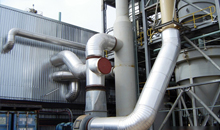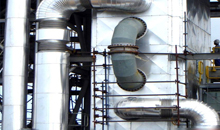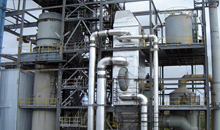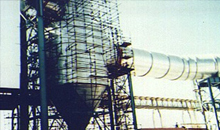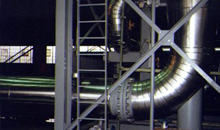Industrial Insulation
By providing the correct insulation you can assure that your operation runs smoothly and that your staff is safeguarded.
In industry insulation to plants and equipment is vital and requires in-depth technical and design expertise. There are several reasons for insulation including conservation of energy, reduction of heat loss, maintaining temperature, maintaining effective operations, preventing condensation, creating comfortable environmental conditions and protecting personnel.
What is Insulation?
Heat is transferred in three ways: conduction, convection and radiation. Thermal conduction is the molecular transport of heat under the effect of a temperature gradient. Convection mechanism of heat occurs in liquids and gases, whereby flow processes transfer heat. Thermal radiation mechanism occurs when thermal energy is emitted similar to light radiation.
Heat passes through solid materials by means of conduction and the rate at which this occurs depends on the thermal conductivity (expressed in W/mK) of the material in question and the temperature drive. In general the greater the density of a material, the greater the thermal conductivity, for example, metals have a high density and a high conductivity.
Materials, which have a low thermal conductivity, are those which have a high proportion of small voids containing air or gas. These voids are not big enough to transmit heat by convection or radiation and therefore reduce the flow of heat. Thermal insulation materials fall into the latter category. Thermal insulation materials may be natural substances or man made.
If the density of the insulation is low, the air or gas voids are comparatively large and this makes for the best insulation for low to medium temperatures where compression and/or vibration is not a factor.
However, where higher temperatures are encountered, the air or gas voids need to be reduced in size to minimise the convection within the voids and this is achieved by increasing the density of the insulation. Density may be increased to a point where the solids content of the insulation is such that heat bridge of the solids overcomes the insulating effect of the voids.
The primary reasons for insulation are many and varied, the main ones being
- To conserve energy
- To reduce heat loss or gain
- To maintain a temperature condition
- To maintain the effective operation of equipment or chemical reaction
- To assist in maintaining a product at a constant temperature
- To prevent condensation
- To create a comfortable environmental condition
- To protect personnel
Hot Insulation
Insulation on equipment plays an important role in the productivity and effectiveness of any industry. The main purpose of hot insulation is to prevent heat loss. Heat loss results in energy loss and that results in inefficient production. By retaining the heat of an item’s contents energy is saved and the temperature of contents can be better controlled, bringing about more effective and economical control of the entire plant. Thus with insulation application comes the responsibility to apply the correct specification and type of insulation appropriate to the requirements of the item to ensure proper insulation and minimal heat loss resulting in maximum heat retention and efficiency.
Not only does insulation result in better performance of plant and equipment but it also acts as protection against extreme temperatures emitted by equipment. By insulating the item the surface temperature is brought down to a safe level for personnel safety.
Equipment or pipework with an operation temperature greater than 55ºC in cases of non-metallic surfaces and 65ºC in the case of non-metallic surfaces should be insulated so that the surface temperature after insulation (cold face temperature) does not exceed 55ºC

